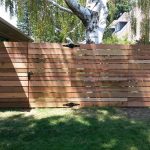3 Tips to Keep Your Wooden Fence in Tip-Top Shape
If you’re considering adding a wooden fence to your property, or if you’ve just installed one recently, it’s important to keep in mind that these fences require regular maintenance to ensure they stay in good condition over the years. Here are three tips on how to properly care for your wooden fence so it can last you and your family for many years to come.
1) Give it Some TLC
Maintaining your wooden fence doesn’t take much, but you do need to be diligent. A little stain, some sealant, and a little effort will go a long way towards keeping your fence looking good for years to come. Start by cleaning it off with a hose — you can use soap if you want, but it isn’t necessary — and then apply a coat of oil or stain every year or two (depending on how frequently it rains). You can also apply additional coats of sealant after each time you clean it. If your fence is made from cedar or redwood, don’t use oil; instead, treat these types of wood with creosote to keep them from drying out.
2) Hire a Professional

Customized fences and gates to match your Colorado residence or commercial property.
You can perform routine fence maintenance on your own, but if you want a long-lasting, beautiful fence that will stay that way for years, it’s best to hire a professional. At Boundary Fence, we can install and repair fences more efficiently than you could ever do yourself. And we know how much extra care wooden fences need to look their best.
3) Protect Your Investment
Keeping your wooden fence well-maintained helps extend its life span and protects your investment. Here are four tips for keeping it protected.
- The first step is proper maintenance, which includes cleaning and repairing any damage to your fence on a regular basis. If you live in an area with harsh winters, you may want to consider adding a protective layer of stain or paint each year before cold weather sets in, as exposure to moisture can lead to rotting and warping over time.
- The second step is knowing what to look out for when making repairs. For example, if you notice splintering along one side of your fence, you might need to replace that board; otherwise, it could become more damaged down the road.
- Make sure that you’re using quality materials when building or replacing sections of your fence. This will help ensure that they last longer and don’t require frequent repairs down the line.
- Finally, have a solid plan in place for replacement. While most fences should last between 10 and 20 years, depending on their type and construction material, there comes a point where they must be replaced rather than repaired — and having a solid plan in place means you won’t have to scramble later on when it comes time to put up new fencing.
While many homeowners choose wood fences because of their aesthetic appeal, few realize how much wooden fence care goes into maintaining them — especially during colder months like winter.







